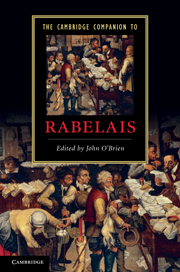Book contents
- Frontmatter
- 1 Introduction
- 2 Reading the works of Rabelais
- 3 Laughing in Rabelais, laughing with Rabelais
- 4 Interpretation in Rabelais, interpretation of Rabelais
- 5 Making sense of intertextuality
- 6 Pantagrueline humanism and Rabelaisian fiction
- 7 Putting religion in its place
- 8 Pantagrue and Gargantua: The political education of the king
- 9 Histories Natural and Unnatural
- 10 Reading and unraveling Rabelais through the Ages
- Guide to further reading
- Index
2 - Reading the works of Rabelais
Published online by Cambridge University Press: 28 January 2011
- Frontmatter
- 1 Introduction
- 2 Reading the works of Rabelais
- 3 Laughing in Rabelais, laughing with Rabelais
- 4 Interpretation in Rabelais, interpretation of Rabelais
- 5 Making sense of intertextuality
- 6 Pantagrueline humanism and Rabelaisian fiction
- 7 Putting religion in its place
- 8 Pantagrue and Gargantua: The political education of the king
- 9 Histories Natural and Unnatural
- 10 Reading and unraveling Rabelais through the Ages
- Guide to further reading
- Index
Summary
Reading Rabelais is no easy matter. His language constitutes an initial obstacle. Replete with clerical,medical, legal, philosophical, scholastic terms and terminology, various classical, foreign, or invented tongues, provincial dialects and urban slang, poems, anagrams, abbreviations, sounds, names, and quotations, his writing displays one of the most varied and extensive lexical ranges of any world author. Intertextuality is rampant, usually displaced by willful distortion. And more is suggested than said, making every word even more polyvalent. Equally disturbing is his recounting the story of a family of giants in a learned, highly literary language. Ultimate meaning, frequently glimpsed but forever elusive, is another. So much so that there are almost as many readings of his works as readers, a positive sign of their successful resistance to any definitive interpretation and a sure criterion of their literariness. At times a single word presents a problem, at times a sentence or a paragraph; but usually it is the determinative intention of a word, an allusion, a chapter or a book, which remains problematic. The weightiest subjects are presented lightly, and trivial matters with great care. Ever-renewable, Rabelais's text is ever-rereadable, inasmuch as it is grounded on differences, sometimes within proximate interpretations, sometimes with alternative possibilities, sometimes both.
- Type
- Chapter
- Information
- The Cambridge Companion to Rabelais , pp. 15 - 30Publisher: Cambridge University PressPrint publication year: 2010

